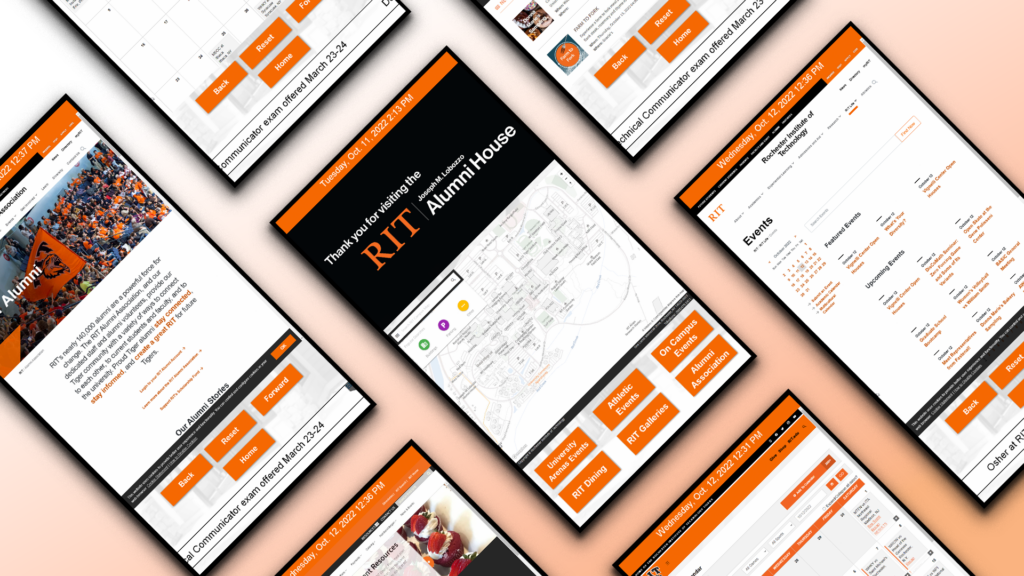CREATING A SIMPLE UI FOR AN INTERACTIVE KIOSK
Interactive Kiosks By Ronnie Pignato
Businesses often find themselves wishing to inform their fellow guests of various events and deals in a timely, yet efficient, manner. Suppose it is desired for your customers to acquire knowledge of specific advertisements as soon as they step through the door, what should their eyes focus to right away? The user interface of your kiosk should be able to catch their attention. The touch screen allows a person to dive directly into the features that interest them the most. As opposed to the traditional printed display, interactive kiosks come with an impressive customizable user interface in which the customer decides which information is important to them. We all know the difficulties of consistently updating those need-to-know advertisements as quickly and professionally as possible, however, with an interactive kiosk in place, any business is able to deliver a facilitated technique to do so. Listed below are the objectives attached to displaying a user interface and the ultimate goal of keeping it simple and easy to follow. Customer service has never been so stress-free.
User Interface Design: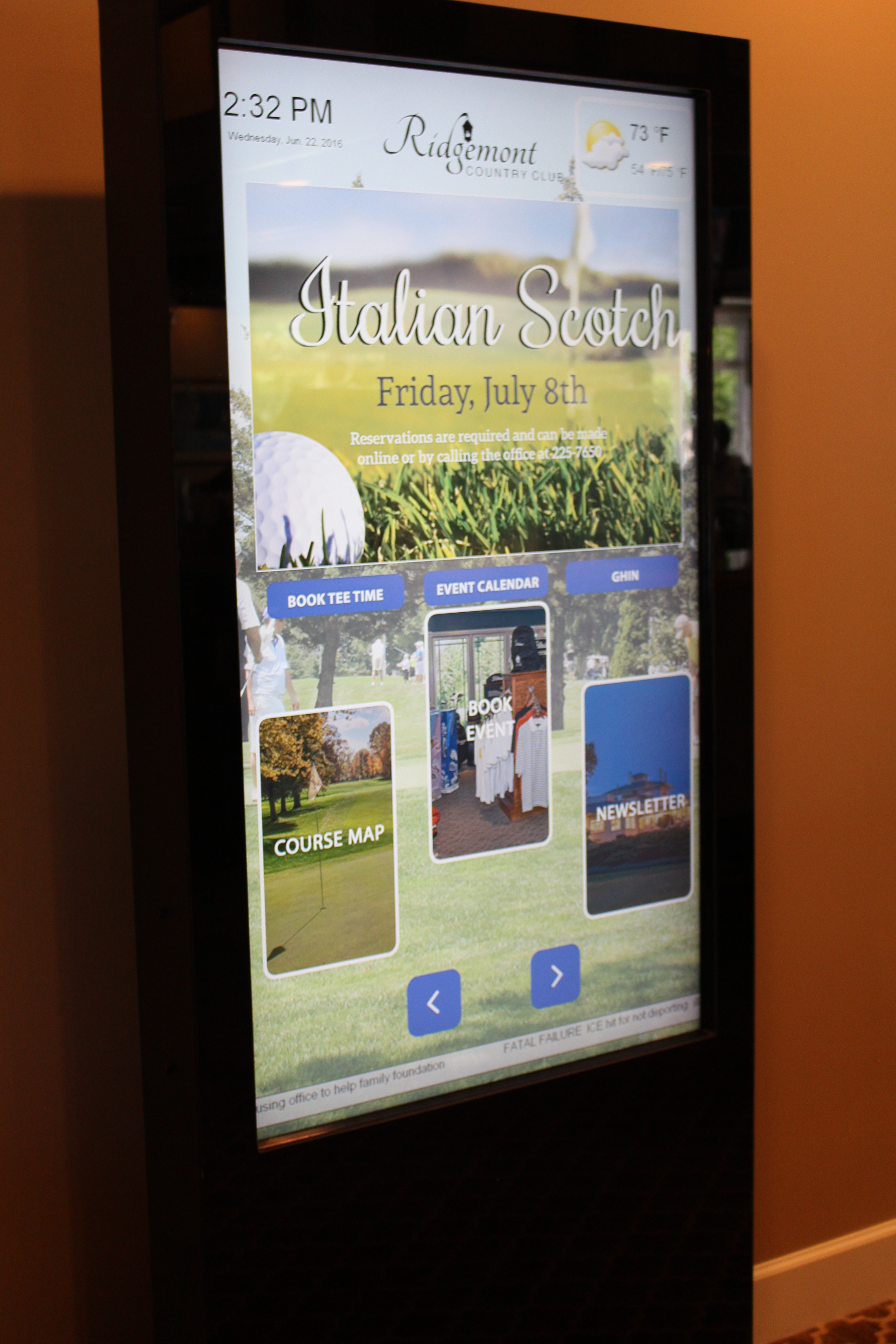
- An Attractive First Impression: Anything touch screen is already appealing to the eye, but what makes them notice this kiosk in the first place? Is it a video playing showing all the options your kiosk has to offer or is it an appealing picture of your building? Movement is key to drawing attention to your kiosk.
- Eye-Catching Appeal: By Utilizing captivating visuals like videos showcasing kiosk options or striking images to attract attention. Movement can be a powerful tool in drawing users in initially.
- Streamline Navigations – Minimize the Amount of Buttons: Starting with the main screen, make sure the user is not overwhelmed with options, but rather can easily decipher where to find their desired information. The purpose is to reduce confusion and increase a users’ ability to search without the help of a worker. By defining clear communication goals, you’ll be able to trim down the amount of buttons needed on the homepage.
- Optimize Page Speed: As you probably assume, no one has the patience for a slow pace, lagging technological item. You want to feel confident knowing when a user clicks on the preferred button, their patience won’t be tested. The information pops up in front of their faces at a rapid speed. Hard lining your kiosk will ensure that all pages load in a timely manner.
- Think like the User: Setup your user interface for your tech-savvy guests, but also those who may not understand a touch screen as easily. Sleek, uncomplicated designs appeal to both parties.
The number one goal behind the addition of an interactive kiosk is to limit the need for human assistance. Interactive kiosks are designed to offer self-service capabilities, reducing reliance on human assistance and providing users with a seamless way to access desired information or services. The primary aim is to streamline the user experience by presenting practical options through a minimalistic interface. Everything the guest desires is supported digitally.
An interactive kiosk helps you steer clear of any hassles that could potentially occur in terms of trying to find specific information on, let’s say, an iPhone or computer. The pure intent of a user interface is to inform the user of various features of a business by presenting only the most practical yet minimal options as possible. With this in mind, the initial arrangement of the user interface is strategically taken into consideration when dealing with anticipated user engagement from the get-go.
The adaptability of touchscreen user interfaces allows for strategic arrangements that cater to anticipated user needs and engagement. This flexibility is a significant advantage, enabling easy adjustments and enhancements to meet evolving user preferences and business requirements.
Transitioning from print to digital with interactive kiosks offers numerous benefits, including dynamic content presentation, ease of updates, and the ability to provide information in a more engaging and accessible manner. This shift reflects the growing trend toward more efficient, user-friendly, and digitally-driven solutions across various industries.
The touchscreen user interface can be altered as many times as need be. This flexibility supports the many reasons why millions of companies are switching from print to digital.
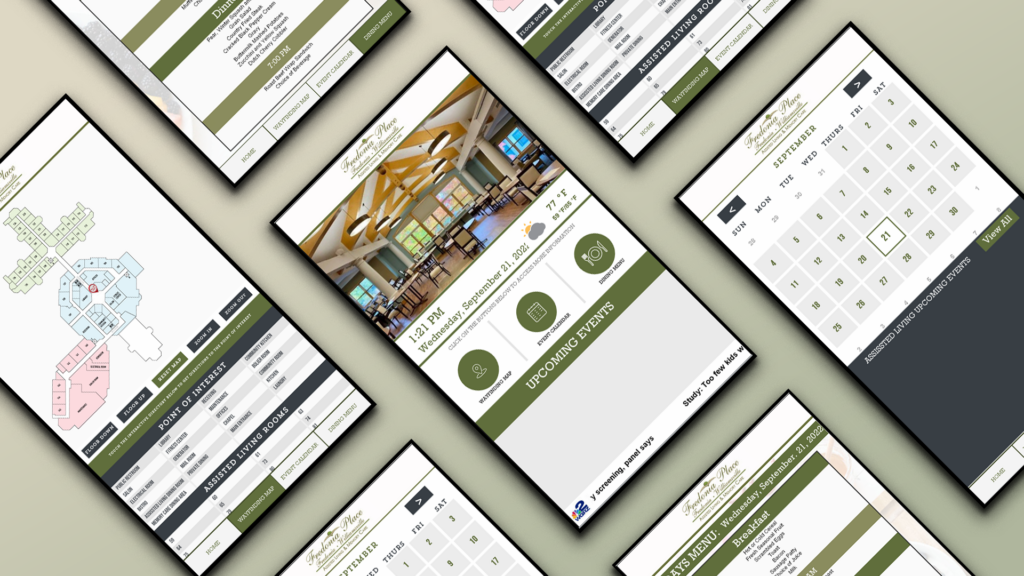
Navigating with Wayfinding
Wayfinding and navigation refer to the features or functionalities within an interactive kiosk that assist users in locating their desired destinations, points of interest, or specific information within a physical space. These elements often include interactive maps, directions, and guidance tools that aid users in navigating through complex environments such as malls, campuses, airports, or large venues. The goal is to offer intuitive and user-friendly tools that help individuals easily find their way and reach their intended locations without confusion or difficulty.
Interactive Kiosk Event Listings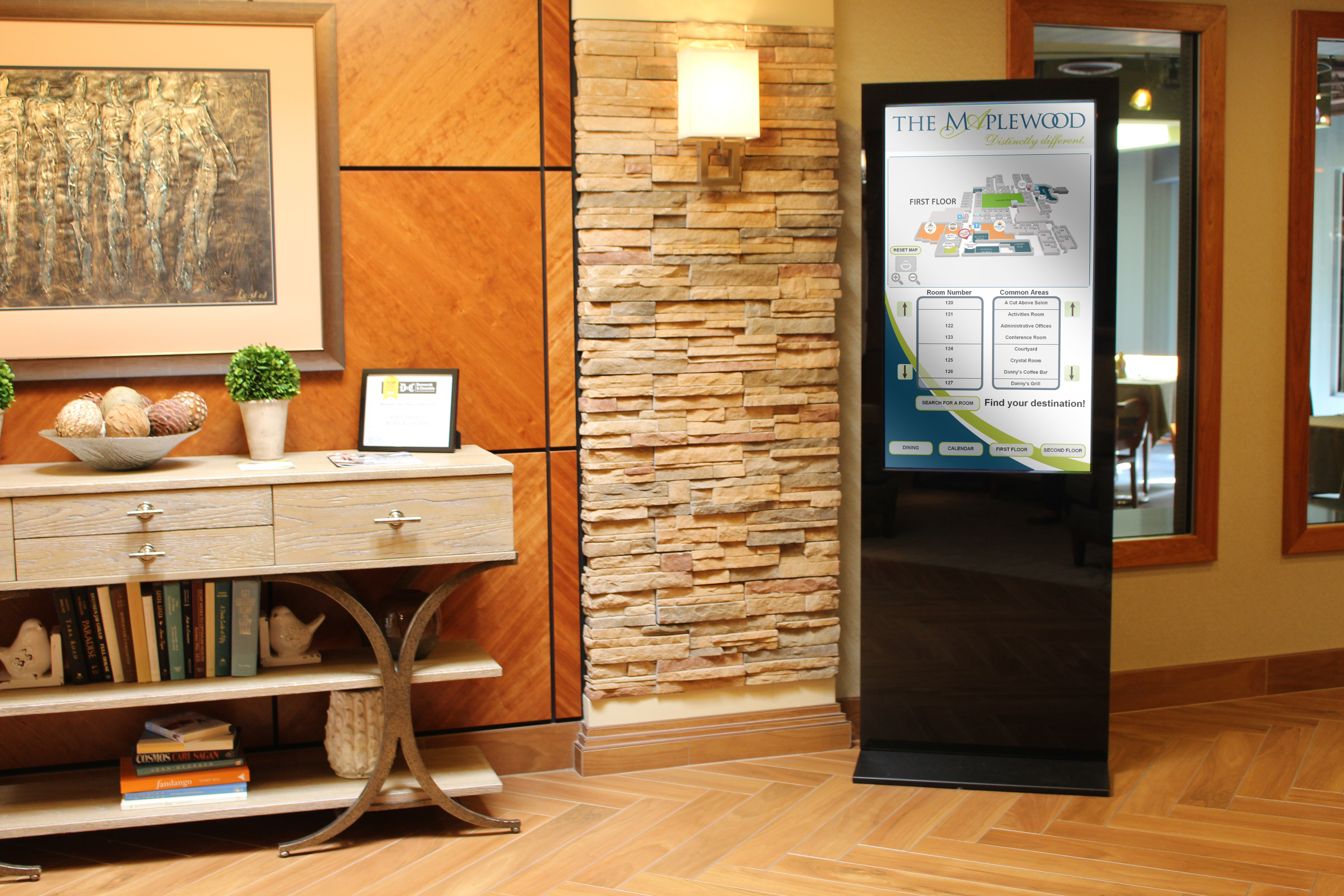
Event listings on an interactive kiosk typically encompass a curated collection of both internal and local events scheduled to occur in proximity to the kiosk’s location. These can include internal events and/ or local events. Your internal events refer more toward activities, promotions, or events organized inside your company. Local or Community events would be festivals, concerts, exhibits, sports events, conferences, etc.
Interactive experiences on interactive kiosks are extremely engaging for users in a more dynamic way. They can range from simple puzzles to more complex challenges, providing entertainment and potentially incentivizing continued interaction. Quizzes offer an interactive way to educate users about products, services, or relevant topics. They can be designed to inform while entertaining, making the learning process enjoyable. Furthermore, survery’s can engage users and gather valuable feedback or data. These surveys can be about their experience with the kiosk or your company, satisfaction with services, or preferences, aiding in business improvements based on customer input.
All of our interactive kiosks offer data collection whether it be behavioral analysis, engagement patterns anf decision making support. User behavior analysis; kiosks collect data on how users interact with the interface, including which options they select, how much time they spend on each section, and the paths they take through the interface. This information provides insights into user behavior patterns and preferences. Engagement patterns; Data analytics track the level of engagement users have with various elements of the kiosk. This includes which interactive features they engage with the most, providing valuable insights into what engages users effectively. Decision making support; By analyzing gathered data, businesses can make informed decisions about content optimization, user interface enhancements, and strategies to improve overall user experience and engagement.
Accessibility Features in Interactive Kiosks
Accessibility services within interactive kiosks play a crucial role in ensuring inclusivity and accommodating diverse user needs. These features are designed to enhance the kiosk experience for individuals with varying abilities and preferences.
Language translation services enable users to access information in their preferred language, breaking language barriers and catering to a wider audience. Voice commands offer a hands-free alternative for interaction, aiding those with mobility impairments or individuals who prefer vocal input. Text-to-speech options assist users with visual impairments by audibly conveying on-screen text and content.
By incorporating these accessibility features, interactive kiosks strive to create a more inclusive environment, empowering all users to engage with the kiosk’s content and services comfortably and effectively.
Training and Educational Resources on Interactive Kiosks
Interactive kiosks serve as versatile tools for providing valuable training and educational resources, benefiting both staff and the public. These kiosks offer a platform to deliver comprehensive training modules, educational content, or informative tutorials tailored to specific needs. For staff members, they become a convenient resource for onboarding, skill enhancement, or updated procedural training. Meanwhile, for the public, these kiosks offer access to educational content, tutorials, or informational resources, fostering learning experiences in various settings such as libraries, museums, or public spaces. This interactive approach not only enhances knowledge dissemination but also facilitates a more engaging and accessible learning environment for all users.
Stay Informed with News and Social Media Feeds on Interactive Kiosks
Incorporating news feeds and social media updates scrolling along the bottom of the user interface creates a dynamic and real-time informational layer within the interactive kiosk experience. These feeds offer users instant access to current events, breaking news, or the latest updates from social media platforms, seamlessly integrated into the kiosk interface. This continuous stream of information keeps users informed and engaged while they interact with the kiosk’s primary content, providing a valuable addition to their overall experience.
Leveraging Marketing and Advertising through Interactive Kiosks
Interactive kiosks serve as powerful marketing tools, allowing businesses to showcase promotions, advertisements, and digital signage effectively. These platforms offer a dynamic space to promote products, services, or upcoming events to a targeted audience. Through captivating visuals, multimedia content, and interactive elements, kiosks engage users, increasing brand visibility and influencing purchasing decisions. This direct and interactive approach enables businesses to effectively communicate their offerings and brand messages, maximizing the impact of their marketing strategies
Online Calendars on Interactive Kiosks
Online calendars integrated into interactive kiosks offer real-time, up-to-date scheduling and event information, ensuring users have access to the latest happenings at their fingertips. These calendars automatically update, displaying current events, appointments, or activities. Users can conveniently browse through the schedule, check for available slots, or plan their activities while interacting with the kiosk. Whether it’s showcasing upcoming events, reservation availability, or highlighting important dates, these dynamic calendars provide users with accurate and immediate information, enhancing their overall experience and facilitating better planning and engagement.
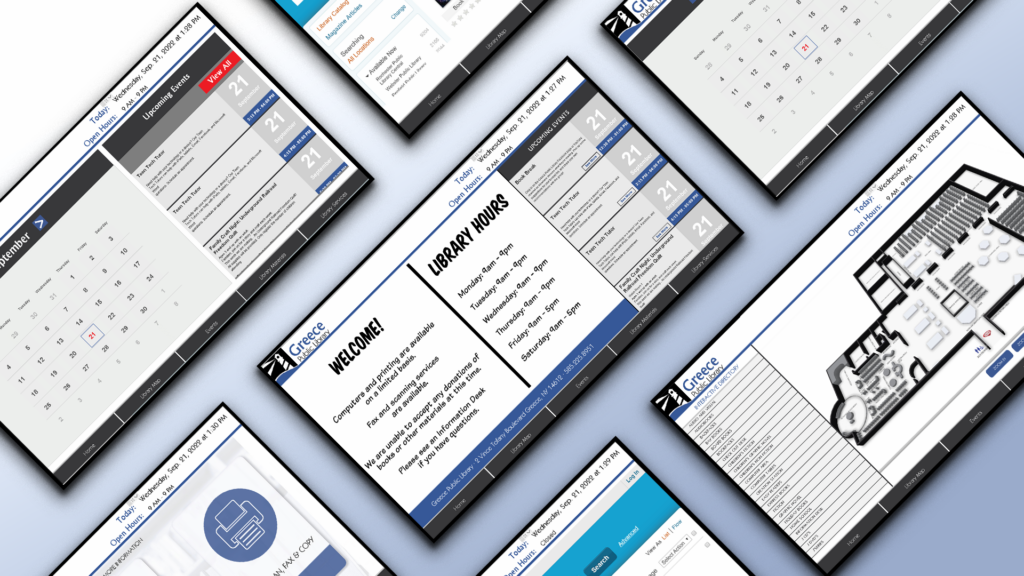
Highlighting Company Offerings Through High-Resolution Photo Galleries
Photo galleries within interactive kiosks present an immersive visual experience, allowing businesses to showcase their products, services, or premises using high-quality imagery. These galleries offer users a captivating glimpse into what the company offers, presenting a visual narrative that communicates the brand’s essence. With high-resolution images, users can explore and appreciate the company’s offerings in detail, fostering engagement and leaving a lasting impression.
Understanding Integration in Interactive Kiosks
Integration in the context of interactive kiosks refers to the seamless amalgamation of various technologies, systems, or functionalities to create a unified and cohesive user experience. Integration involves webpages, roombooking software, ILS catalogs, any type of API and more to work together efficiently within the kiosk ecosystem. This integration can encompass linking databases for real-time information updates, connecting to external systems for transactions, or syncing various technologies to deliver a comprehensive and interconnected user interface. The goal of integration is to create a holistic and user-friendly experience that streamlines operations and enhances the kiosk’s functionality and usability.
The kiosk interface is crafted to ensure customers feel at ease while familiarizing themselves with a business. It’s purposefully designed to deliver pertinent information that aligns with various facets of the business. When approaching an interactive kiosk, users should effortlessly discern where to start exploring without the need for assistance. The goal is to offer a seamless experience that eliminates the necessity for users to ask questions, empowering them to navigate the interface intuitively and access relevant information without any hurdles.
Factors presented within the kiosk are designed to ease a customer into being as comfortable as possible when getting to know a business. The kiosk is intended to provide relevant information coordinating with the different elements held within each business. When stepping in front of an interactive kiosk, one should have a clear idea of where to begin and, most importantly, to do so without the need to ask questions.
Click for more information on interactive kiosk design.



